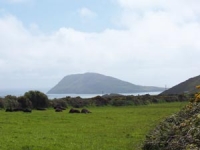40 Big Cat Sightings Reported In Cumbria
40 BIG CAT SIGHTINGS REPORTED IN CUMBRIA is the name of an article by Matthew Legg that appeared in the News & Star on 15th November 2011.
Police have received 40 reports of big cats roaming the Cumbrian countryside since 2003.
But no evidence has ever been found to back up any of the claims.
The majority refer to big black panther-type creatures or lynxes.
One sighting of a “large black cat” dead beside the M6 was found to be an otter.
And after investigating a report of “big black cat” at Troutbeck Bridge, near Windermere, officers concluded it was probably a badger.
Cumbria Police has thrown open its files on big cat sightings after a request by the News & Star under Freedom of Information rules.
They include:
A “black panther” on the fells at Garrigill, near Alston in 2003.
A “very large cat” at Bewcastle in 2003.
A “large puma-type black cat” near the River Eden at Linstock, Carlisle. in 2003.
A “big cat” which looked like a lynx on the lane leading to Silloth Golf Club in 2003.
A “large wild cat” near the A596 at Wigton in 2003.
A “black panther” near a football pitch on the Great Broughton to Dearham road in 2004.
A “2ft high puma” at Tirril, Penrith, in 2005.
A “lynx” next to the A591 at Applethwaite, near Keswick, in 2005.
A “panther” at Derwentwater, Keswick, in 2006.
A “large black cat” in fields above Townfoot Park, Brampton, in 2007.
A “large black cat” at Port Road business park, Carlisle, in 2009.
A “large black panther cat” at Eastern Way, Carlisle, in 2010.
In 2003, a lion was spotted in a field opposite South Lakes Wild Animal Park at Dalton-in-Furness, near Barrow.
However, officers sent to the scene found no evidence of the animal being there.
Checks at the zoo found that all of its lions were accounted for.




Re: 40 Big Cat Sightings Reported In Cumbria
I think that many ABC sightings are a result of mis-identification. I remember having an apparent ABC sighting of my own when out walking with my outdoor sports college group in winter 2009/2010 in the lake district.
There was a lot of snow on the ground and we were traversing a steep slope, moving slowly as we had to kick steps in at some places. There was 8 of us in the party. Ahead of us, a spur came out of the side of the slope. All of a sudden, a black figure shot up the side of the spur ahead of us and down the other side. We all saw it as there were exchanges of looks and exclaimations of "what the hell was that?!" Most of us thought it must have been a big cat, with the agility it moved up the steep, snow covered slope. When we finally arrived at the spur, we diecided to investigate it further, which was very difficult as the spur was very steep and covered in hard, compact snow. By kicking steps, a few of us managed to reach the point where the creature climbed up the slope and found it’s tracks. Having a knowledge of tracks, I managed to confirm that it was actually a fox. The contrast with the snow must have made it appear black, and foxes and dogs are almost as agile as cats, which many people are suprised to find out.
As many ABC sightings occur at a distance, it is very difficult to judge size and type of the creature. It may also be the case that people do not investigate these sightings further before reporting them.
It would also be interesting to see what time of day and in what conditions the above sightings were reported. If they were reported at dusk/dawn, it would be tricky to determine colour. Do you have any more information Ian?
Re: 40 Big Cat Sightings Reported In Cumbria
Ha-ha!
Love it!
Here is a picture of 9 months old Maine Coon kitten 🙂
This one is blue, but they do come in black too.
They keep growing till they are 2 years old….
The one spotted in Cumbria (as well as one spotted in Devon a few years back) might be microchipped domestic cuddly purring laidback puss. Lucky owners, but they should’ve warned neighbourhood and a postmen !
Re: 40 Big Cat Sightings Reported In Cumbria
There are definitely "big cats" roaming the countryside, but most sightings tend to be exaggerated to say the least.
Dr Karl Shuker carried out a long investigation in the Midlands (starting with the discovery of the so-called Ludlow Cat as a roadkill, which he acquired and had mounted by a taxidermist) which turned out surprising results.
The Ludlow Cat itself was positevely identified as a pure-blood Jungle Cat (Felis chaus). It pretty much looks like a very large tabby with more powerful teeth, ear tufts and proportionately longer limbs.
Jungle Cats can mate with domestic cats and the offsprings are fertile, so much they are commonly sold as "Chausie".
First generation hybrids tend to resemble a Jungle Cat in general outline but usually lack ear tufts and exhibit an enormous variety of coat colors. Curiously enough melanism is very common among these hybrids.
Second generation hybrids tend to be more akin to domestic/feral cats, the main tell-tale signs being the large size and long limbs.
Not far from where the Ludlow Cat was found, an old lady found a young, starving kitten she took in and simply named "Mother". She was first generation hybrid and proved to be extremely prolific, delivering many large litters, though the other parent was invariably unknown.
Two of her kittens were later traced down (they had been given as pets to a local family) and confirmed to be second generation hybrids.
This of course doesn’t mean every single "big cat" sighted in Britain is domestic/Jungle hybrid, just the problem is much more complicated than it seems.
Re: 40 Big Cat Sightings Reported In Cumbria
Fears that black panthers are roaming the Scottish countryside following the release of the Helensburgh mobile phone footage have been firmly debunked by international experts. According to big cat conservationist Dr Luke Hunter, And the lack of evidence leads Dr Hunter to remain unconvinced about the existence of big cats in Scotland.
But experts have examined the shaky footage and say the animal’s characteristics are typical of a domestic cat.
Rob Weaver, a BBC wildlife presenter and film-maker, said it would be very unusual for a big cat to calmly walk around in a public place.
“The small, almost dainty steps the creature takes along the rail are not characteristic of a puma, or a similar big cat, which tend to have a far more loping gait,” he said.
The footage looks very much like a very well fed domestic cat to me. ‘Leopards (black panthers are melanistic leopards) do not carry their tails upright, which you see in the footage, while domestic cats characteristically do. He added ‘I’ve seen big cats –leopards, lions, cheetahs, jaguars, tigers and cougars – in the wild thousands of times and nothing about this footage has the appearance or look and feel of any of those species. No way is this a big cat.’
Graham Law, a zoologist at Glasgow University who has worked with leopards for 23 years, also said the animal was more likely to be of the domestic variety.He said: “The video isn’t of a good enough quality to verify exactly what the animal is. A leopard would not confidently walk down a railway line. It would more likely move along the sleepers or stay in heavily forested areas.
Application of Locard’s Exchange Principle as well as the Application of the Simons Test. Then we have Dr Luke Hunter of Panthera (well respected) & Dr Alan Rabinowitz, as well as Dr Graham Law as well as Prof McDonald, and so on who disagree completely and have shown this in the Black Beast of Exmoor Documentary. Until there is fact and proof then this myth will continue as a crank subject. Even Mark Fraser said it was a crank subject before he closed down BCIB.
After all these years of these mythical big cat sightings in the UK and still no fact and proof. Tunbridge the so-called big cat tracker from Stroud still can not show any of his big cats. Then we have McGowan and the rest of the fantastists who swear that these cats are here and breeding? Such fools try to use ego, hype, big words and "I am an expert" or "I know what I am talking about" rubbish. They say big cats are breeding in the UK; big cats are doing this and that in the UK. BS..
Despite the usual dross from others saying that big cats frequent railway lines, really? Since when do cats read train time tables…? Saying that zoo keepers and the lady in the monster quest documentary taking about what is and is not a big cat. She never "forced" her opinion on anyone. Unless these UK big cat crypto groups and groupies can come up with real hard science fact and truth, showing that such mythical cats do exist. breeding and wild, then sadly they have no reply. No big cats..
Scott Lope of Big Cat Rescue, who was used on the MonsterQuest: Black Beast of Exmoor TV episode 2008 said: "these are seen as minor scratches, not consistent with any width or claws of any big cat or wild cat. I would seriously doubt that this was caused by a big cat other than a domestic cat or by oneself." Then we have Dr Luke Hunter of Panthera (well respected) & Dr Alan Rabinowitz, as well as Dr Graham Law as well as Prof McDonald, and so on, who all disagree with this myth hype.
Cryptozoology concerns itself with unknown species for which there are "myths" and with supposedly-extinct species. Strictly-speaking, a species that is simply unknown is not cryptozoological. Cryptozoology" is that it is not a legitimate field of science. Any idiot can call himself a cryptozoologist as if it means something important and it does not. A zoologist is a legitimate title, as is geologist, biologist, etc. Cryptozoologist means nothing.
Dr Nick Royle, a senior lecturer in Behavioural Ecology at Exeter University, said people could overestimate the size of animals, which could explain sightings.
He said that research conducted at the university had shown that when viewing an object that was the size and shape of a large domestic cat at a distance of 230ft (70m) from them 21% of people estimated the ‘cat’ to be the size of a leopard or larger.
Dr Royle said: "The research showed that people can estimate regular shapes such as rectangles of different sizes correctly at distance, but have difficulty estimating the size of cat-shaped objects.
Application of Locard’s Exchange Principle as well as the Application of the Simons Test. Then we have Dr Luke Hunter of Panthera (well respected) & Dr Alan Rabinowitz, as well as Dr Graham Law as well as Prof McDonald, and so on who disagree completely and have shown this in the Black Beast of Exmoor Documentary. Until there is fact and proof then this myth will continue as a crank subject. Even Mark Fraser said it was a crank subject before he closed down BCIB.
Sorry, but no "big cats" wild, free or breeding within the UK.